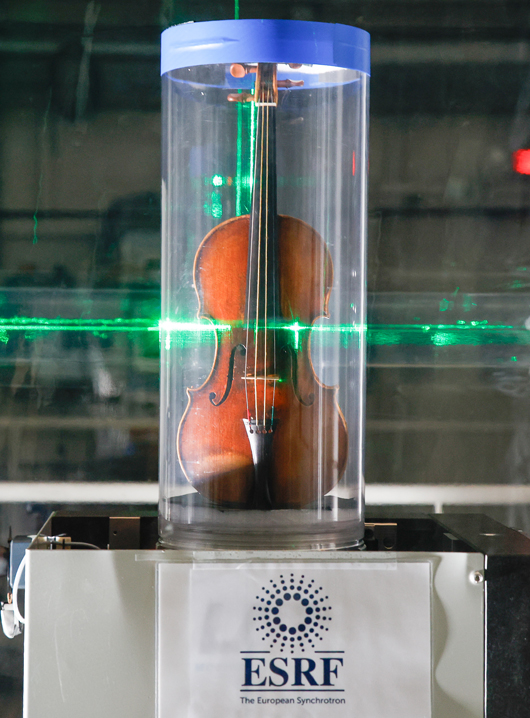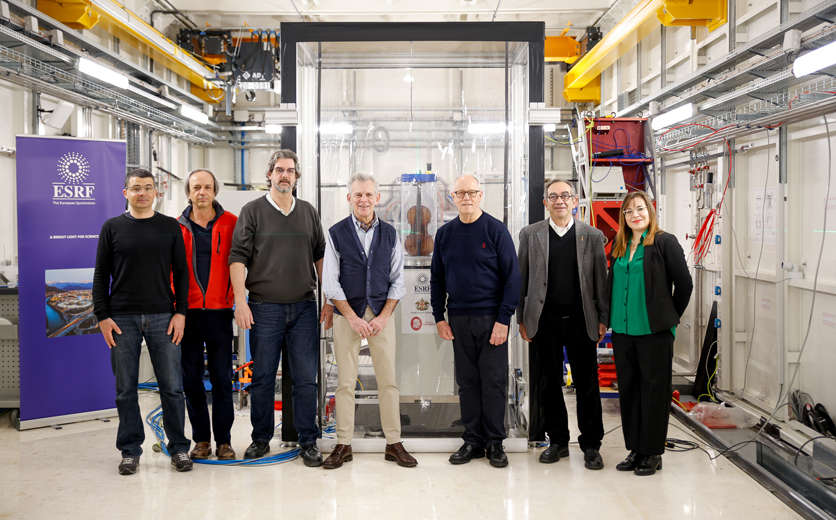- Home
- News
- General News
- Paganini’s violin...
Paganini’s violin « Il Cannone » undergoes ESRF's X-ray analysis
11-03-2024
The ESRF played host to the most famous violin in the world: 'Il Cannone', crafted in 1743 and reputedly the favourite violin of the Italian virtuoso Niccolò Paganini. The Municipality of Genoa and the Premio Paganini teamed up with ESRF scientists to carry out an in-depth X-ray analysis of the iconic violin.
The conservation of ancient violins of historical and cultural high interest, such as “Il Cannone”, Niccolò Paganini’s favourite violin, which ranks among the most important musical instruments in the history of Western music, requires constant monitoring of their state of health.
Conservators and researchers teamed up to preserve "Il Cannone"
The Municipality of Genoa in Italy and the Premio Paganini have developed a programme with the ESRF for an in-depth monitoring and analysis of the behaviour of the violin in different situations, in order to better preserve and understand this precious historical artefact. In this context, the Municipality of Genoa and its conservators have teamed up with ESRF scientists to define a measurement protocol and perform a unique experimental X-ray study – using non-destructive X-ray techniques – of the structural status of the wood and the bonding parts of the violin. Working day and night, they used a technique called multi-resolution propagation phase-contrast X-ray microtomography at the ESRF’s new BM18 beamline to scan the violin.
‘ll Cannone’ was built in 1743 by the great Cremonese luthier Bartolomeo Giuseppe Guarneri, also known as ‘del Gesù’. Paganini enjoyed an almost symbiotic relationship with what he called “my cannon violin” for its acoustic prowess. The ‘Cannone’ became an exceptional partner for the virtuosities of the musician, who developed new violin techniques by exploiting the instrument’s potential to the full. Niccolò Paganini left the ‘Cannone’ to his hometown, Genoa, “so that it may be perpetually preserved.” The violin has been kept in Palazzo Tursi, the seat of the Municipality of Genoa since 1851. The ‘Cannone’ is rarely played. Some famous violinists have performed with the ‘Cannone’ in concerts in Italy and abroad; however, playing the precious instrument remains a privilege reserved for the winner of Genoa’s biennial Premio Paganini International Violin Competition.
ESRF-EBS provided a new insight into the iconic violin
Using multi-resolution propagation phase-contrast X-ray microtomography, a non-destructive technique widely used at the ESRF for palaeontology, the team was able to reconstruct a 3D image of the violin at the level of its cellular structure, with the possibility to zoom in locally anywhere in the violin, down to the micrometric scale. In addition to revealing "Il Cannone"’s conservation status and structure, the results hint at the interventions made by luthiers throughout the instrument’s life.
The study of Paganini’s violin was made possible by the new capabilities of ESRF-Extremely Brilliant Source, combined with the unique performances of the new BM18 beamline. With an increased X-ray brightness and coherent flux 100 times higher than before, the facility allows complex materials to be imaged more quickly and in greater detail.
“This fantastic experience, undertaken with my colleagues at the ESRF and with the conservators of the “Cannone” violin, opens new possibilities to investigate the conservation of ancient musical instruments of cultural interest, as a crossing point between music, history and science”, says Luigi Paolasini, ESRF scientist and the project leader.
 |
| Close-up view of Paganini's "Il Cannone" on the experimental station BM18 at the ESRF. Credit: ESRF/P. Jayet |
"It was a kind of dream to work on this violin. BM18 can be considered as currently the best place in the world to conduct such an experiment. We had to deal with some logistical and technical challenges, but the ESRF team did an incredible job to make this dream a reality. I hope that this experiment will be the first in a long series. In few months, we will even be able to work on much larger instruments, up to the size of a double-bass”, says Paul Tafforeau, ESRF scientist in charge of BM18.
“The microtomographic investigations undertaken at the ESRF represent one of the most important events in the second life of the ‘Cannone’; for us, conservators, working with such a team of scientists and with such fantastic equipment is an unforgettable experience. It’s a starting point for a better understanding of this irreaplaceable and still mysterious violin”, say Bruce Carlson, Alberto Giordano and Pio Montari, conservators of the “Cannone” violin.
 |
| On the ESRF's BM18 experimental station, teams from the ESRF, the Genoa Municipality, the Premio Paganini and the violin conservationists stand on either side of the "Il Cannone". The precious violin is placed inside protective casing ready for non-invasive analysis using the ESRF's high performance X-rays. Credit: ESRF/P. Jayet. Left to right: Nicola Sodini (Elettra, Trieste), Alessandro Mirone (ESRF), Paul Tafforeau (ESRF), Alberto Giordano (lute conservationist), Bruce Carlson (assistant lute conservationist), Luigi Paolasini (ESRF), Chiara de Marco (Genoa Municipality). |
Quote from Francesco Sette, ESRF, Director General
“ESRF’s mission is to serve the users of our Member Countries and the international community by enabling state-of-the-art investigations of the structure of materials, from the atomic all the way up to the macroscopic scales. The present study on “Il Cannone” is a wonderful example of ESRF non-destructive 3D X-ray imaging techniques enabling qualitative progress in the understanding of how this precious artifact is made, a key-step for its conservation for the next generations”.
Quote from Marco Bucci, Mayor of Genoa
“This extraordinary event interweaves culture, science, history and music around the most famous violin in the world which Paganini himself chose to entrust our city with, for it to be conserved forever. May we continue to safeguard the “Cannone” and honour its worth.”
Quote from Giovanni Panebianco, President of the Premio Paganini Prize
“The diagnostic test was carried out as part of an unprecedented international cooperation centred around excellence and distinction. The Paganini Committee has facilitated the conditions for achieving a result that has been awaited for years. I would like to thank Francesco Sette, Luigi Paolasini and the entire team who worked alongside the Cultural Policy Department and the luthiers of the Municipality of Genoa. A heartfelt thank you to all those who have supported the initiative in their various capacities, in particular to Emanuela D’Alessandro, the Italian Ambassador in France, and to Chiara Petracca, Consul General in Lyon.”
Quote from Barbara Grosso, Managing Director of the Municipality of Genoa
“Now that it has had this important check on the state of its health, I hope that Paganini’s “Cannone” can more often excite enthusiasts from all over the world and be an ambassador for our city. Thanks to the Municipality offices responsible for the procedures that enabled the violin to be transported to Grenoble, to the luthiers Bruce Carlson and Alberto Giordano who followed the process from the preparatory stages, and the Sponsors AXA XL and Associazione A Compagna, Technical Sponsors of the Paganini Violin’s journey.”
Quote from Enrico De Barbieri, Paganini Ambassador and member of the Paganini Committee
“It is a pleasure and an honour to be here. So many personal and family memories come to mind. Today I am witness to a truly special moment which makes me proud as a Genoese. My father Renato and my grandfather Paolo would be equally proud of this, as their lives have been linked to Paganini, the Premio and the Cannon” – comments Enrico De Barbieri, Paganini Ambassador and member of the Paganini Committee.
Quote from Chiara Petracca, Consul General of Italy in Lyon
“Due to the workmanship and the prestige of its owner, the “Cannone” can be considered one of the most important musical instruments in the world and it is essential to ensure its conservation.
I am therefore very excited to be part of the international collaboration started by the Municipality of Genoa and the Premio Paganini with a research centre with outstanding excellence such as the ESRF and I am particularly grateful to all those who have worked on this project for having combined science and the most advanced technologies in the name of art.”
Top image: The "Il Cannone" is protected inside glass casing for non-invasive X-ray analysis on BM18. From left to right: ESRF scientists, Paul Tafforeau and Luigi Paolasini, Bruce Carlson, conservatory luthier and Alberto Giordano assistant conservatory luthier. Credit: ESRF/P. Jayet



